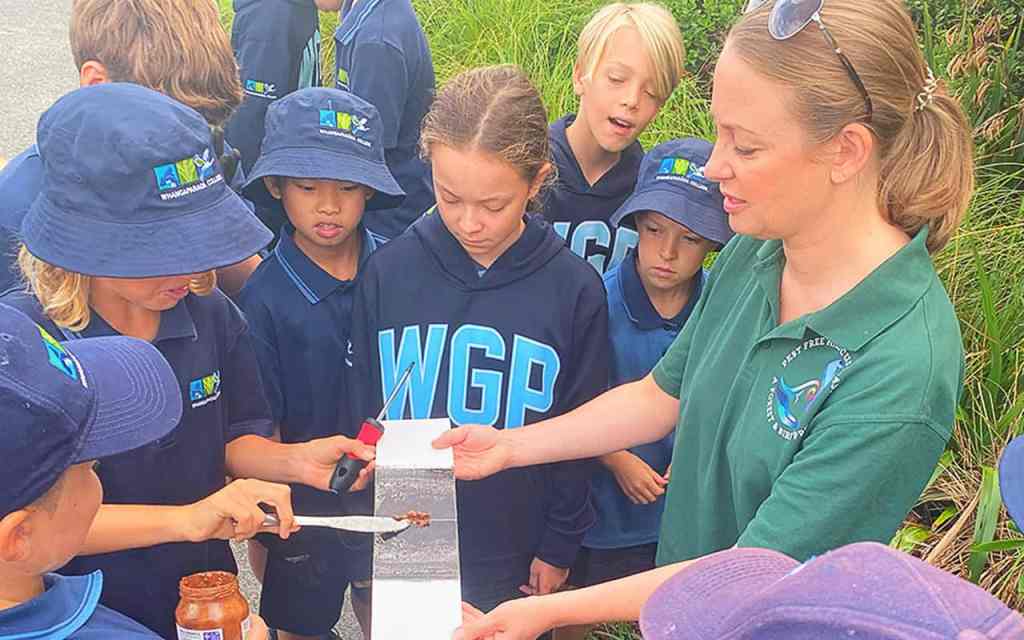
As part of Forest & Bird’s Pest Free Hibiscus Coast Project, the team have been working with schools across the Hibiscus Coast for several years, with one clear goal – connecting children and their families to nature conservation in their community. Over the last five years, we have worked with 13 schools, including the unique Forest School. We have done presentations and workshops with over 4000 students from ages five to 17, attended careers events, and had stalls at school galas to connect with families.
We find that children value nature and are quite shocked at the threats facing what we take for granted every day. One thing we need to work to avoid is children inheriting the concept that some adults have, that nature is only of value where we can get something from it, or that our rare species should be confined only to pest free islands and sanctuaries, and we can do what we like with the rest. It’s reassuring to hear that so many children recognise the intrinsic value of nature, and that wild creatures have as much right to live here as we do.
What can be challenging is presenting the concept of Predator Free 2050 and the need to remove introduced animal pests. How do we align killing with conservation in a way that is appropriate for children? This has turned out to be less difficult than we thought, because when we tell the stories about how these animals were brought here, and the damage they have done, they recognise that we have a duty as New Zealanders to put right those mistakes and be the guardians of our amazing species. Endemism, the term used to describe species only found here, is an important one.
Forest & Bird’s education sessions focused on the Pest Free Hibiscus Coast project currently start with a take on the famous Bird of the Year competition, with children learning about the quirks of six of the Coast’s native birds before deciding on their favourite and casting their vote. We talk about the “why” behind conservation work and, in particular, predator control. With 40 per cent of species found locally classed as being ‘at risk’ or worse, and the incredible taonga species at Shakespear and Tiritiri Matangi so close by, taking action here is relevant.
The children learn about the introduced mammals, discovering the amazing but treacherous abilities of the stoat and the breeding rate of the rat, and getting hands on with study skins. We don’t want children to hate these animals, it’s about understanding that they are in the wrong place and going back to those hard choices.

We stress the importance of using the right tool for the job and selecting humane tested traps. With older students, they get to choose the device that they use, learning about newer technologies like self-resetting traps, but also weighing up the cost of devices against frequency of servicing. Many schools have a trap line in their school grounds, looked after by keen groups of children of all ages.
We are always blown away by the knowledge and excitement kids already have before we visit. Most are able to answer questions about pest animals and native birds correctly, or at least with a huge amount of enthusiasm. Being able to regularly spend time with classes and develop relationships with them has been incredibly beneficial for all involved. Our goal of a pest free haven is understood by the next generation, and they take great pride in being able to contribute to that vision.

If you are a teacher or a parent and would like to find out more about Forest & Bird’s visits to Hibiscus Coast schools, contact Charlie on [email protected]
Many of New Zealanders grew up with access to wild places and experiences that are becoming increasingly limited for the next generation. For example, swimming off clean beaches and popping manus into fresh, cool rivers and lakes with no risk of sewage. Right now we are at risk of losing New Zealand’s world leading freshwater protections, that are improving the poor state of our lakes and rivers, as the current government plans to change them. If you value freshwater, visit our website for more about our freshwater campaign. www.forestandbird.org.nz/petitions/stop-destroying-our-freshwater-protections
Pest detectives – Many schools follow up the indoor sessions with some hands of activity, and often start by finding out what’s out there when setting up a trap line. The tracking cards reveal ink footprints, while the chew cards leave tell-tale bite marks. In some cases, trail cameras are used or the students are shown footage from elsewhere.
by Jenny Hanwell & Charlie Thomas, Hibiscus Coast Forest & Bird
[email protected], [email protected]

